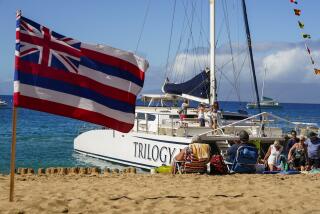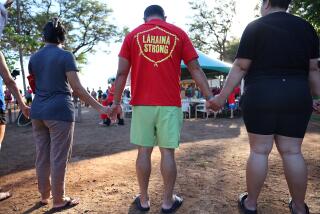Volcano watchers in Hawaii trekked dangerously close to Kilauea’s lava — and got caught
- Share via
If you’re thinking about straying beyond the boundaries to get a closer look at the lava flow from Hawaii Volcanoes National Park, think again.
A group of tourists faces fines after rangers found them in an out-of-bounds area close to the erupting Kilauea volcano on Hawaii Island.
The 13 visitors, who were part of a tour group, were ticketed in the March 6 incident and asked to leave the park. Park rangers said the tour group specializes in up-close-and-personal encounters with volcanoes all over the globe.
The citations for entering a closed area carry fines of $100. The tour guide faces additional charges that carry stiffer fines and potential jail time.
On Dec. 31, 26 acres of land, called a lava delta, collapsed into the ocean. Less than a half-an-hour before the collapse, five tourists had strayed onto the site, CBS News reported. Rangers chased then back.
In the March 6 incident, tourists were at Halemaumau crater at summit of the Kilauea volcano. An eruption there in August sent molten lava and volcanic rock hurtling nearly 300 feet beyond the crater rim, destroying scientific equipment.
Since 1990, five visitors have died in off-limits areas. Hyperthermia and inhalation of lung-searing steam were among the causes of death.
Kilauea began erupting again in 1983. Its lava flow has added nearly a square mile of land mass to Hawaii Island.
Two of the four most destructive volcanic eruptions in history have occurred in what is now Indonesia. In 1815, Mt. Tambora erupted, killing about 92,000 people as a result of the blast and the ensuing destruction of food sources.
In 1883, Krakatoa erupted. Its caldera collapsed and took with it nearly nine square miles of land. About 36,000 people died.
In 1902, Mt. Pelee in Martinique exploded, killing 29,000 people, and in 1985, Mt. Ruiz in the Colombian Andes erupted, killing 25,000.
On the U.S. mainland, Mt. St. Helens, in the Cascade Mountains of southwestern Washington state, erupted in May 1980. Fifty-seven people and thousands of animals died.
A lateral blast destroyed more than 200 square miles of forest worth millions of dollars. It was the most destructive and financially disastrous volcanic event in U.S. history, according to the National Geophysical Data Center.
If you plan to visit, check current conditions at the park’s website.
ALSO
New luxury resort to open at Maui’s famed Kaanapali Beach
More to Read
Sign up for The Wild
We’ll help you find the best places to hike, bike and run, as well as the perfect silent spots for meditation and yoga.
You may occasionally receive promotional content from the Los Angeles Times.






